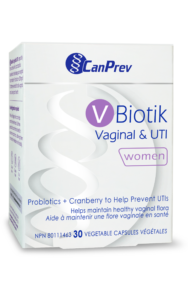When something is off “down there”, it can feel uncomfortable, embarrassing and downright inconvenient. But the truth is, the majority of people with vaginas will experience vaginal imbalances at some point in their lives. Occasional imbalances are totally normal, be it in the form of a urinary tract infection (UTI), a yeast infection or bacterial vaginosis (BV). But if these conditions are frequent reoccurrences for you, it may be time to give your vaginal flora some attention.
What is vaginal flora and why is it important for vaginal health?
Much like the gut microbiome, the vagina also contains a rich ecosystem of beneficial bacteria that crowd out harmful invaders and potential pathogens. Healthy vaginal flora also protects against imbalances caused by lifestyle habits, stress and low-nutrient diets.
The main beneficial strain of bacteria that protects the vagina is Lactobacillus. It protects against various infections by producing lactic acid to inhibit the growth of bad bacteria. Too many harmful bacterial or fungal strains in your vaginal flora may cause bacterial vaginosis (BV), vaginal yeast infections, or UTIs.
Experiencing the occasional vaginal infection or UTI poses relatively little harm. However, chronic or recurrent vaginal imbalances can have serious, long-term implications for reproductive wellness, fertility and vaginal health.
UTI, yeast infection, or BV: which is it?
Common vaginal imbalances can share similar symptoms, which makes it hard to tell them apart. If you experience any of the following symptoms, talk to your healthcare practitioner. They can test you and help find the right remedy that will provide symptom relief and address its true root cause.
UTIs
A urinary tract infection (UTI) is a common bacterial condition that comes with symptoms of burning sensation while peeing, cloudy urine, pain in the abdomen, and urinary urgency.
Yeast infection
Imbalances in vaginal flora can allow Candida, a harmful yeast, to overcrowd beneficial bacteria. This causes yeast infections, which are most commonly caused by Candida (and other fungal strains) and come with symptoms of itching, burning, and swelling in the vulva and vagina.
Bacterial vaginosis
And finally, bacterial vaginosis (BV) is caused by bacteria and has similar symptoms to a yeast infection – except for a telltale fishy smell that accompanies the itching, burning, and pain.
What causes UTI, yeast infection, and BV?
UTIs, yeast infections, and BV can happen for a variety of reasons. Pregnancy, cyclical hormonal fluctuations, sexual activity, and antibiotic use are all common causes.
Pregnancy
Because the growing fetus can put pressure on the bladder and urinary tract, many pregnant women find themselves more prone to UTIs. What’s more, changes in hormone levels during pregnancy also alter the vaginal flora, leading to a higher risk of yeast infection or BV.
Cyclical hormonal fluctuations
Do you always get a vaginal infection right before your period? There’s a reason for that. Changes in estrogen to progesterone balance during the luteal phase of the menstrual cycle make the vaginal flora more prone to infections like Candida overgrowth.
Sexual activity
Introducing a new sexual partner to the vaginal ecosystem can change the vaginal pH and temporarily change the bacterial ecology of the vagina. Multiple sexual partners can also have the same effect, which might make you more prone to UTIs and infections for some time, until the vaginal flora returns to balance. Remember to practice safe sex!
Antibiotic use
Finally, antibiotic use is a common cause of vaginal flora imbalances in many women. Antibiotics are great for wiping out harmful bacteria that are behind sickness and infection, but they can also wipe out our protective Lactobacillus, leading to an unbalanced vaginal flora.
How can you maintain healthy vaginal flora?
With a few simple lifestyle tips, it’s easy to support a healthy vaginal flora and lower the risk of infection.
Foods to focus on
Foods rich in probiotics such as yogurt, kombucha, and nutrient-rich fermented vegetable support your vaginal flora with friendly bacteria. Whole grains and root veggies offer important prebiotics, which act as food for our friendly bacteria.
Supplements for daily care
Lactobacillus bacteria is especially important for the vaginal ecosystem. Aside from dietary choices, you might consider supplementing with probiotics to meet your daily needs. In particular, it’s helpful to look for probiotics specifically for vaginal use – because our vaginal flora is so delicate, daily care is important to ensure that our friendly bacteria is getting everything it needs to stay healthy and thriving. This one also contains cranberry extract – a lifesaver for recurring UTIs.
Medicinal herbs and mushrooms with a strong benefit for vaginal health include calendula, turkey tail, and reishi. While calendula acts as an antibacterial and antifungal, medicinal mushrooms like turkey tail and reishi help support a healthy immune system that fights off harmful organisms.
Hygiene tips
General hygiene and lifestyle tips for better vaginal health and a balanced ecosystem in the vagina can do wonders in the prevention of UTIs, yeast infections and bacterial vaginosis. Avoid scented intimate products and douches. Wear comfortable, breathable underwear and make a habit of changing out of wet exercise wear or swimsuits.
Caring for vaginal health and your beneficial flora can take many forms: be it through diet tweaks, medicinal herbs, probiotics, or lifestyle tips. This is a commitment to health you’ll be rewarded with over and over.


